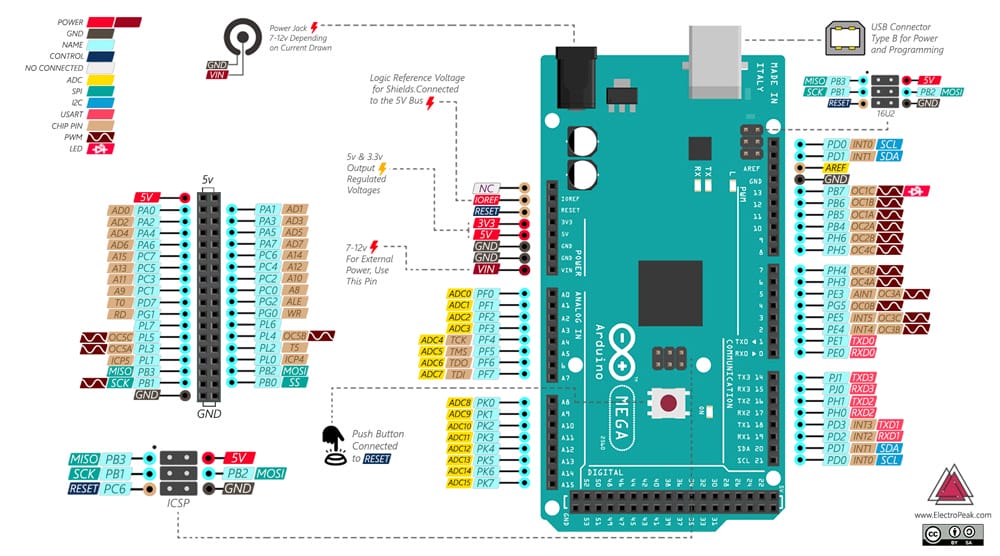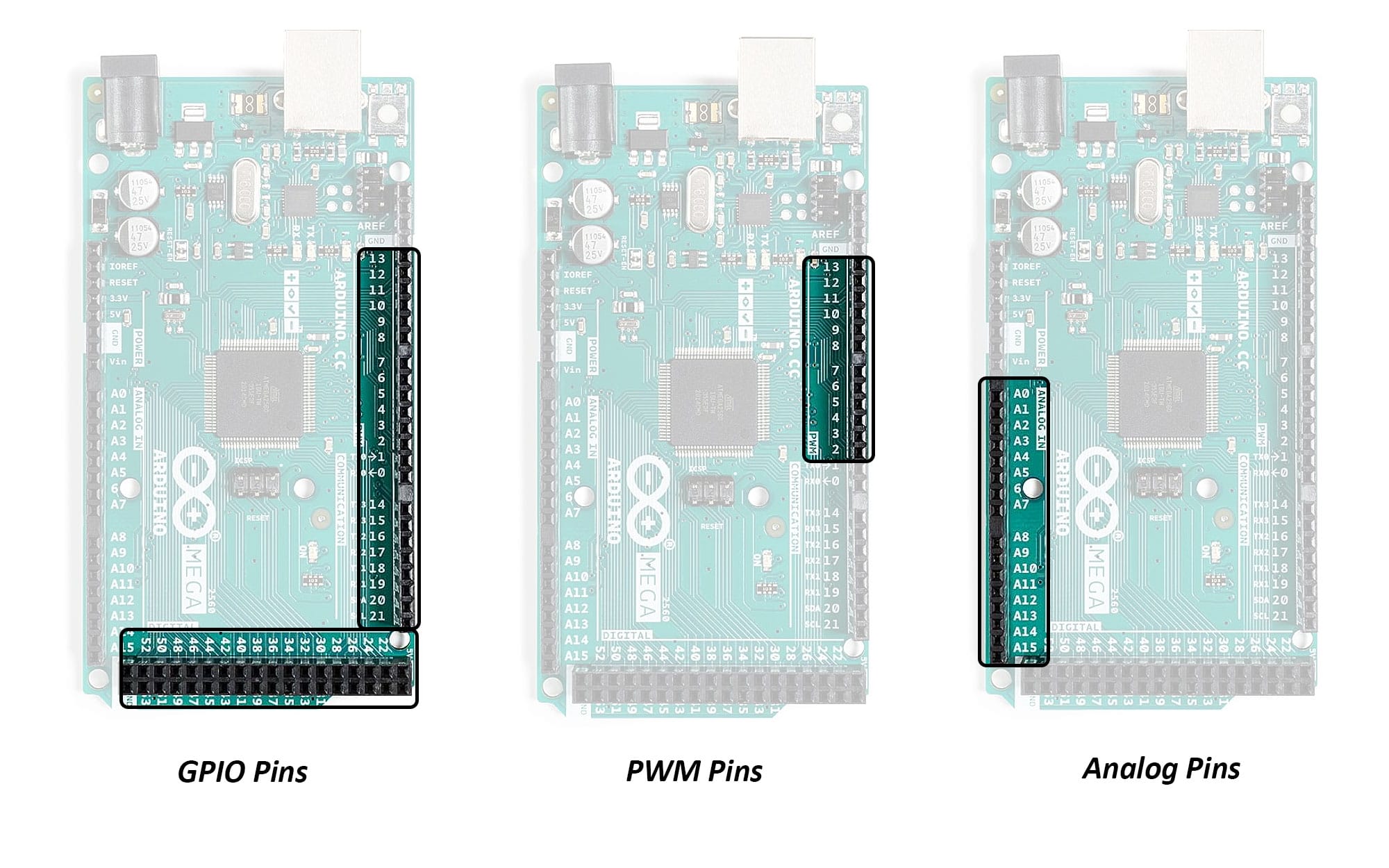The Arduino MEGA 2560 R3 (CLONE) can be powered via the USB connection to a computer, an AC-to-DC adapter (7-12V DC), or a battery.
Arduino Mega 2560 R3 (Clone)
Volume discounts:
- +25 4 % $16.3100
- +50 6 % $16.0000
- +100 7 % $15.6800
- +300 9 % $15.3600
- +500 11 % $15.0400
-
Protective Transparent Acrylic Case For Arduino Mega 2560$0.6500
-
Arduino Mega R3 Shell (Black)$1.5000
 Arduino Nano
Previous
Arduino Nano
Previous

An Arduino Mega 2560 R3 (Clone) is a replica or imitation of the original Arduino Mega 2560 R3, which is an official Arduino board. Clones are typically produced by third-party manufacturers and are designed to be functionally equivalent to the official boards. These clones are often more affordable than official Arduino products, making them popular among hobbyists and makers on a budget. While the components and layout may vary slightly from the original, the Mega2560 clone is compatible with the Arduino software and can be programmed using the same IDE, making it a practical choice for those seeking a budget-friendly option for their projects.
Arduino Mega 2560 is a microcontroller board based on the ATmega2560. It has 54 digital input/output pins (15 of which can be used as PWM outputs), 16 analog inputs, a 16 MHz ceramic resonator, a USB connection, a power jack, an ICSP header and a reset button. This makes it ideal for complex projects requiring numerous sensors, actuators, and communication interfaces.
It contains everything needed to support the microcontroller; simply connect it to a computer with a USB cable or power it with an AC-to-DC adapter or battery to get started.
Features of Arduino Mega 2560 R3 (Clone)
- Dimensions : 101.52 mm x 53.3 mm
- Microcontroller : ATmega2560
- Operating Voltage : 5V
- Input Voltage (recommended) : 7-12V
- Input Voltage (limit) : 6-20V
- Digital I/O Pins : 54 (of which 15 provide PWM output)
- Analog Input Pins : 16
- DC Current per I/O Pin : 20 mA
- DC Current for 3.3V Pin : 50 mA
- Flash Memory : 256 KB of which 0.5 KB used by bootloader
- SRAM : 8 KB
- EEPROM : 4 KB
- Clock Speed : 16 MHz
- LED_BUILTIN : 13
Difference between Arduino Mega 2560 R3 original and its clone
Arduino Mega 2560 R3 boards can be found both in original versions produced by Arduino and in clones manufactured by various Chinese companies.
We will introduce you the differences that the original Arduino board and the copy may have.
It is necessary to point out that the version that is sold on our site is an exact clone of the original board and in terms of functionality and quality, they are not different from the original version.
Here are some general differences that are often observed between original Arduino Mega 2560 R3 boards and their Chinese clones:
- Build Quality: Original Arduino boards are typically manufactured to higher quality standards. The components used, soldering quality, and overall build may be superior to some Chinese clones.
- Component Quality: Original Arduino boards often use higher-quality components, which can contribute to better performance and durability. Chinese clones may use cheaper components to reduce costs.
- Pricing: Original Arduino boards are generally more expensive than Chinese copies. The lower cost of Chinese copies may make them attractive to budget-conscious users.
- Clones and Variations: Some Chinese clones are exact clones of the original Arduino Mega 2560 R3, while others may have slight variations in design or component placement.
- Manufacturing Origin: Original Arduino boards are manufactured in Italy or other authorized locations. Chinese clones, as the name suggests, are often manufactured in China.
It's important to note that not all Chinese copies are of poor quality, and some functions perfectly well. However, users should be aware of potential differences in quality when choosing between an original Arduino Mega 2560 R3 and a Chinese clone.
Considering the price difference in most cases, buying a quality copy of Arduino is a more suitable option for most users.
Pinout of Arduino MEGA 2560 R3 (CLONE)
The Arduino MEGA 2560 R3 (CLONE) board has various pins, including digital input/output pins, analog input pins, power pins, and communication pins. Here's a breakdown of the pins on an Arduino MEGA 2560 R3 (CLONE):
There are totally 20 I/O pins. Which 14 of them are digital I/O and 6 of them are Analog Inputs.
- Digital I/O Pins (D0-D53): Pins D0 to D53 are digital input/output pins. They can be used for both digital input (reading HIGH or LOW) and digital output (providing HIGH or LOW).
- Analog Input Pins (A0-A15): Pins A0 to A15 are analog input pins. They can be used to read analog signals from sensors or other devices.
- 5V: Provides a regulated 5V power output.
- 3V: Provides a regulated 3.3V power output.
- GND (Ground): Ground pins for connecting to the ground of the circuit.
- PWM (Pulse Width Modulation) Pins: Pins D3, D5, D6, D9, D10, and D11 support PWM, allowing for analog-like output using pulse-width modulation.
Below figure, you can see Arduino MEGA 2560 R3 (CLONE) general pinouts.
Communication interfaces of Arduino MEGA 2560 R3 (CLONE)
The Arduino MEGA 2560 R3 (CLONE) board supports several communication interfaces, allowing it to interact with other devices and components. Here are the main communication interfaces of the Arduino MEGA 2560 R3 (CLONE) :
- Serial Communication (UART): RX (D0) and TX (D1): These pins are used for serial communication. The Arduino MEGA 2560 R3 (CLONE) can communicate with other devices, such as computers or other microcontrollers, using the Universal Asynchronous Receiver-Transmitter (UART) protocol.
- I2C (Inter-Integrated Circuit): SDA (A4) and SCL (A5): The Arduino MEGA 2560 R3 (CLONE) supports I2C communication, a two-wire serial communication protocol. It allows multiple devices to communicate over a shared bus.
- SPI (Serial Peripheral Interface): MISO (D12), MOSI (D11), SCK (D13), and SS (D10): These pins are used for SPI communication, a synchronous serial communication protocol commonly used for interfacing with sensors, displays, and other devices.
- Analog-to-Digital Converter (ADC): A0 to A5: These pins can be used for analog input. The Arduino MEGA 2560 R3 (CLONE) has a built-in ADC, allowing it to convert analog signals from sensors or other devices into digital values.
- PWM (Pulse Width Modulation): D3, D5, D6, D9, D10, D11: These pins support PWM, allowing the Arduino MEGA 2560 R3 (CLONE) to simulate analog output by varying the duty cycle of a digital signal. PWM is often used for controlling the brightness of LEDs or the speed of motors.
- External Interrupts: D2 (interrupt 0) and D3 (interrupt 1): These pins can be used for external interrupts, allowing the Arduino MEGA 2560 R3 (CLONE) to respond to external events, such as a button press or a change in a sensor's state.
How to Use Arduino Mega 2560 R3 (Clone)?
Step 1: Install the Arduino Software (IDE)
Download the Arduino IDE (Integrated Development Environment) from the official Arduino website.
Install the software on your computer.
Step 2: Connect Arduino to Your Computer
Connect your Arduino Mega 2560 R3 (Clone) to your computer using the USB cable.
The Arduino should power up, and you may see the onboard LED (near pin 13) blinking.
Step 3: Set Up Arduino IDE
Open the Arduino IDE on your computer.
In the IDE, go to Tools > Board and select "Arduino Mega 2560 R3 (Clone).€
Go to Tools > Port and select the port that corresponds to your Arduino (it usually says "Arduino Mega 2560 R3 (Clone)").
Step 4: Write and Upload Your First Sketch
In the Arduino IDE, go to File > Examples > 01.Basics > Blink. This will open a simple Blink sketch.
Read through the code to understand how it works.
Click the right-pointing arrow button (Upload) to compile and upload the sketch to your Arduino.
You should see the onboard LED blinking.
What are the best alternatives to Arduino Mega 2560 R3 (Clone)?
If you want the same frame factor microcontroller-based boards, then you can choose between bellow boards:
- Arduino Due: Based on a more powerful ARM Cortex-M3 processor. Faster clock speed and more memory, suitable for more demanding applications.
- STM32 Nucleo Boards: Based on ARM Cortex-M processors. Offers a wide range of features and compatibility with the Arduino IDE through the STM32 Arduino core.
- Arduino UNO R4 Minima: The Arduino UNO R4 Minima represents an evolution of the classic UNO R3 development board, upgrading the 8-bit AVR microcontroller to a 32-bit Arm Cortex-M4 while retaining the same form factor. This allows enhanced performance and memory in a familiar package compatible with existing Arduino shields and accessories.
- Wemos D1 ESP8266/32: The WeMos D1 Mini is an inexpensive ESP8266-based WiFi board that is low-profile but just as powerful as any NodeMCU or ESP8266-based microcontroller. The D1 Mini is fully compatible with the Arduino platform.
- UNO D1 R32: Wemos D1 R32 is ESP32 Based WiFi/Bluetooth Board in Arduino MEGA 2560 R3 (CLONE) form factor. The MEGA 2560 R3 (CLONE) form factor lets you use existing Arduino Shields with ESP32 Wireless CPU.
If frame factor doesn't matter to you, there are options below:
- Arduino Nano: Smaller form factor compared to Mega 2560 R3 (Clone) . Similar functionality but more compact, making it suitable for projects with space constraints.
- ESP8266 (NodeMCU): Includes built-in Wi-Fi connectivity. Ideal for IoT (Internet of Things) projects where internet connectivity is required.
- ESP32: Dual-core processor and Bluetooth in addition to Wi-Fi. Provides more processing power and additional communication options.
- Raspberry Pi Pico: The Raspberry Pi Pico is a microcontroller board designed for embedded applications, IoT projects, and electronics prototyping. It is powered by the RP2040 microcontroller, a dual-core ARM Cortex-M0+ processor, offering high performance and flexibility.
FAQs
Here are some frequently asked questions (FAQs) about the Arduino MEGA 2560 R3 (CLONE) R3:
How do I power the Arduino Mega 2560 R3 (Clone)?
What is the difference between digital and analog pins on the Arduino MEGA 2560 R3 (CLONE)?
Digital pins can be used for digital input or output (HIGH or LOW), while analog pins can read analog signals, such as those from sensors, and convert them to digital values. Note that, analog pins can be used as digital pins.
Can I program Arduino MEGA 2560 R3 (CLONE) with Python?
Yes. But it€™s better not to do this. If you interested in Python programming, you can use Raspberry Pi pico or ESP32/8266 based development boards.
What programming language does Arduino Mega 2560 R3 (Clone) use?
Arduino MEGA 2560 R3 (CLONE) is programmed using a simplified version of C/C++. The Arduino IDE provides a user-friendly interface for writing and uploading code.
What is the maximum current I can draw from each pin on Arduino Mega 2560 R3 (Clone)?
Can I use shields designed for Arduino boards with Arduino Mega 2560 R3 (Clone)?
In most cases, yes. Arduino MEGA 2560 R3 (CLONE) is compatible with many shields designed for other Arduino boards. However, some shields may require adjustment for pin compatibility. You can choose and buy the one you want from the variety of shields available on the site.
What is the purpose of the AREF pin on the Arduino MEGA 2560 R3 (CLONE)?
How do I upload code to the Arduino MEGA 2560 R3 (CLONE)?
Code is uploaded to the Arduino MEGA 2560 R3 (CLONE) using the Arduino IDE (Integrated Development Environment) via a USB connection. For more information, please read this topic.
What can I do with Arduino MEGA 2560 R3 (CLONE)?
The Arduino MEGA 2560 R3 (CLONE) is a versatile microcontroller board that can be used for a wide range of projects in various domains. Here are some common applications and things you can do with an Arduino MEGA 2560 R3 (CLONE):
Sensor Projects:
Connect various sensors such as temperature, humidity, motion, or light sensors to monitor and gather data from the environment. You can choose and buy the one you want from the variety of sensors available on our website.
Home Automation:
Build simple home automation projects, like controlling lights, fans, or other devices using relays or smart home modules.
Robotics:
Create robots using motors, servos, and sensors. You can build line-following robots, obstacle-avoidance robots, or even remote-controlled robots.
IoT Projects:
Connect your Arduino MEGA 2560 R3 (CLONE) to the internet using Ethernet shield and create Internet of Things (IoT) projects. For example, you could monitor sensor data remotely or control devices through a web interface.
LCD Displays:
Interface with LCD displays to show information or create user interfaces for your projects.
Security Systems:
Build basic security systems using motion detectors, cameras, and alarms.
The possibilities with Arduino MEGA 2560 R3 (CLONE) are vast, and the open-source nature of the Arduino platform means there is a wealth of resources, tutorials, and community support available to help you with your projects. Whether you're a beginner or an experienced maker, Arduino MEGA 2560 R3 (CLONE) provides a great platform for learning and creating.
What projects should I not use Arduino Mega 2560 R3 (Clone) for?
While the Arduino Mega 2560 R3 (Clone) is a versatile and widely used microcontroller board, there are certain types of projects for which it may not be the most suitable choice. Here are some scenarios where other microcontrollers or development platforms might be more appropriate:
- High-Performance Computing: f your project requires substantial computational power, such as complex mathematical calculations, intensive signal processing, or running resource-demanding algorithms, you might want to consider microcontrollers or development boards with more powerful processors, such as those based on ARM Cortex-M or Cortex-A architectures.
- High-Frequency Signal Processing: Arduino Mega 2560 R3 (Clone), like many microcontrollers in its class, might not be suitable for projects requiring high-frequency signal processing or real-time control in the range of tens of megahertz or higher. In such cases, specialized platforms with dedicated signal processing capabilities may be more appropriate.
- Graphics and Multimedia Applications: Projects involving graphics, multimedia, or advanced display requirements may benefit from microcontrollers with dedicated graphics processing units (GPUs) or platforms specifically designed for multimedia applications.
- Large-Scale Data Processing: If your project involves handling large datasets or performing extensive data processing, you might consider platforms with more memory and processing power, such as single-board computers (SBCs) or more advanced microcontrollers.
- Professional Embedded Systems: For commercial or industrial applications that demand more robustness, reliability, and certification, professional-grade microcontrollers or embedded systems designed for specific industries may be preferable over hobbyist platforms like Arduino MEGA 2560 R3 (clone).
- Battery-Powered Projects with Stringent Power Constraints: If your project requires ultra-low power consumption and long battery life, there are microcontrollers specifically designed for low-power applications. Arduino MEGA 2560 R3 (CLONE), with its onboard components and power regulation, may not be the most power-efficient choice for battery-powered projects with stringent power constraints.
- Real-Time Operating System (RTOS) Applications: f your project requires a real-time operating system for precise timing or multitasking, there are microcontrollers and platforms specifically designed for running RTOS, which might be more appropriate than the Arduino MEGA 2560 R3 (CLONE) .








Please complete your information below to login.
Sign In
Create New Account